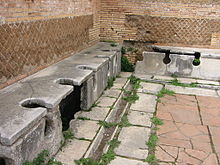
Back مرحاض المعسكر Arabic Latrina Catalan Latrino Esperanto Letrina Spanish Karkaba Basque Latrines French Latrina Galician לטרינה HE Latrin HT Cubluk ID



1) Bench
2) Main water channel
3) Front water channel
4) Wall
5) Window
6) Divider
7) Washbasin
A latrine is a toilet or an even simpler facility that is used as a toilet within a sanitation system. For example, it can be a communal trench in the earth in a camp to be used as emergency sanitation, a hole in the ground (pit latrine), or more advanced designs, including pour-flush systems.
The term "latrine" is still commonly used military parlance,[1] and less so in civilian usage except in emergency sanitation situations.[2] Nowadays, the word "toilet" is more commonly used than "latrine", except when referring to simple systems like "pit latrines" or "trench latrines".[3]
The use of latrines was a major advancement in sanitation over more basic practices such as open defecation, and helped control the spread of many waterborne diseases. However, unsafe defecation in unimproved latrines still remained a widespread problem by the end of 2020, with more than 3 billion people affected (46 % of the global population). Eradication of this public health threat is one of the United Nations' 17 goals for sustainable development.[4]
- ^ "Field Facilities for Human Waste Disposal". Army Study Guide. Archived from the original on 24 May 2021. Retrieved 24 May 2021.
- ^ Peter Harvey; et al. (2007). Excreta disposal in emergencies a field manual : an inter-agency publication. Loughborough: Loughborough university. Water, engineering and development centre (WEDC). p. 250. ISBN 9781843801139. Archived from the original on 2017-10-11. Retrieved 2018-03-28.
- ^ CDC (2024-11-06). "Global Water, Sanitation and Hygiene". Global Water, Sanitation, and Hygiene (WASH). Retrieved 2025-01-05.
- ^ Okram, Julion (2021). "Inadequate sanitation: Monitoring and prospective eradication by 2030". Archived from the original on 26 August 2021. Retrieved 26 August 2021.